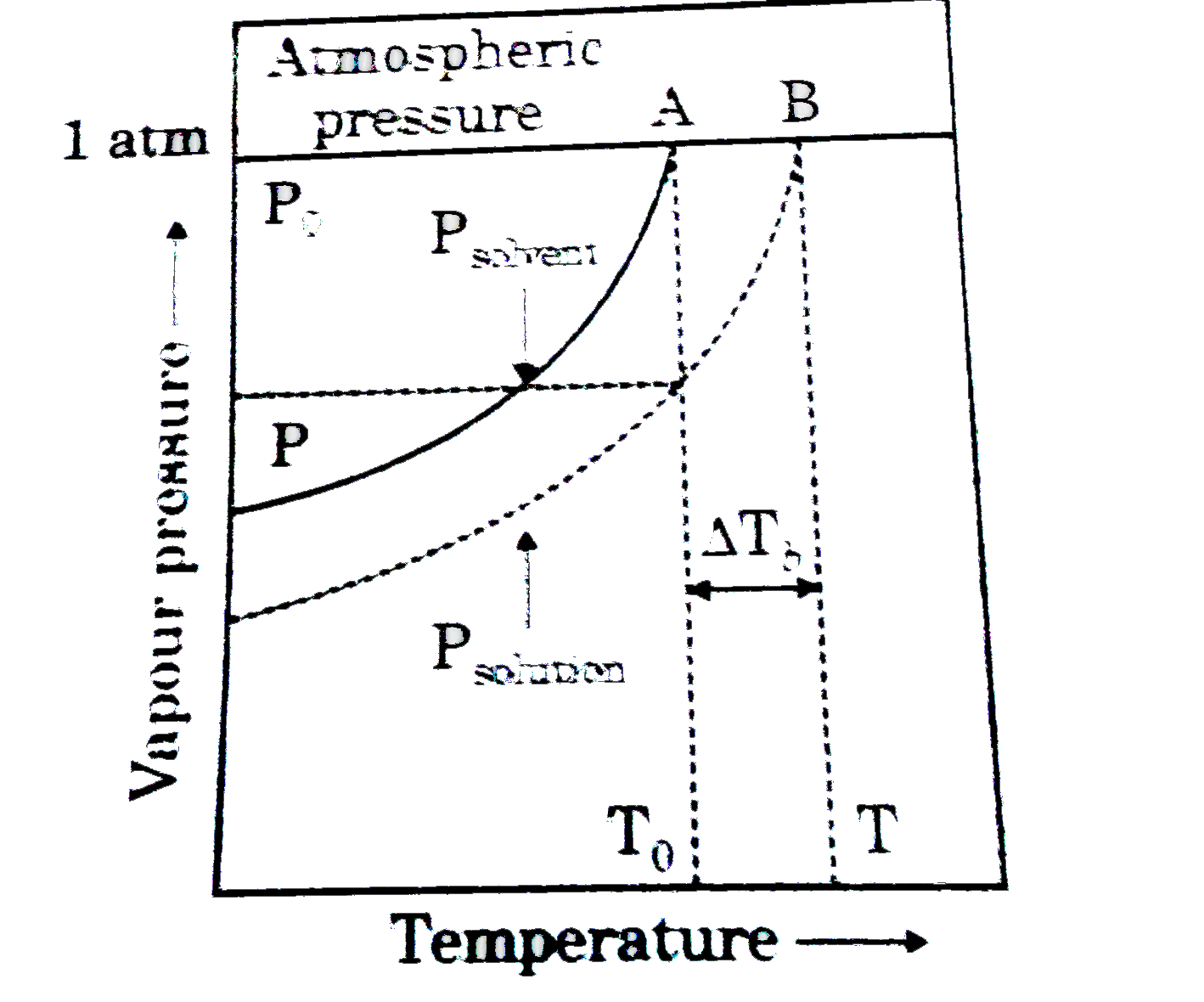The relative decrease in VP of an aqueous glucose dilute solution is found to be 0.018. Hence, the elevation in boiling point is (it is given 1molal aqueous urea solution boils at 100.54∘)C at 1atm pressure)
0.018∘
0.18∘
0.54∘
0.03∘
The correct Answer is:C
To solve the problem, we need to find the elevation in boiling point of an aqueous glucose solution given the relative decrease in vapor pressure. Here’s a step-by-step solution:
Step 1: Understand the relationship between vapor pressure and mole fraction
The relative decrease in vapor pressure (ΔP) is given by the formula:
P0−PP0=χsolute
where P0 is the vapor pressure of the pure solvent, P is the vapor pressure of the solution, and χsolute is the mole fraction of the solute.
Step 2: Calculate the mole fraction of solute (glucose)
Given that the relative decrease in vapor pressure is 0.018, we can equate this to the mole fraction of glucose:
χglucose=0.018
Step 3: Relate mole fraction to moles of solute and solvent
Let nsolute be the moles of glucose and nsolvent be the moles of water. The mole fraction of glucose can be expressed as:
χglucose=nsolutensolute+nsolvent
Assuming nsolute=0.018, we can rearrange the equation to find nsolvent:
0.018=0.0180.018+nsolvent
Cross-multiplying gives:
0.018+nsolvent=0.018⟹nsolvent=0.982
Step 4: Calculate the weight of the solvent (water)
The number of moles of water can be converted to grams using the molar mass of water (18 g/mol):
Weight of water=nsolvent×18 g/mol=0.982×18=17.676 g
Step 5: Calculate the molality of the solution
Molality (m) is defined as the number of moles of solute per kilogram of solvent:
m=nsoluteWeight of solvent in kg=0.01817.676×10−3≈1.018 mol/kg
Step 6: Use the boiling point elevation formula
The boiling point elevation (ΔTb) can be calculated using the formula:
ΔTb=Kb×m
where Kb is the ebullioscopic constant. However, we can use the boiling point elevation of a 1 molal urea solution as a reference:
Given that a 1 molal urea solution boils at 100.54∘C, we know:
ΔTb for urea=0.54∘C
Step 7: Calculate the elevation in boiling point for glucose
Since the molality of glucose is 1.018 (which is close to 1), we can find the new boiling point elevation:
ΔTb=0.54×1.018≈0.5498∘C
Thus, the boiling point of the glucose solution will be:
100+0.5498≈100.55∘C
Final Answer
The elevation in boiling point of the aqueous glucose solution is approximately 0.55∘C.
---
The relative decrease in vapor pressure (ΔP) is given by the formula:
P0−PP0=χsolute
where P0 is the vapor pressure of the pure solvent, P is the vapor pressure of the solution, and χsolute is the mole fraction of the solute.
Given that the relative decrease in vapor pressure is 0.018, we can equate this to the mole fraction of glucose:
χglucose=0.018
Let nsolute be the moles of glucose and nsolvent be the moles of water. The mole fraction of glucose can be expressed as:
χglucose=nsolutensolute+nsolvent
Assuming nsolute=0.018, we can rearrange the equation to find nsolvent:
0.018=0.0180.018+nsolvent
Cross-multiplying gives:
0.018+nsolvent=0.018⟹nsolvent=0.982
The number of moles of water can be converted to grams using the molar mass of water (18 g/mol):
Weight of water=nsolvent×18 g/mol=0.982×18=17.676 g
Molality (m) is defined as the number of moles of solute per kilogram of solvent:
m=nsoluteWeight of solvent in kg=0.01817.676×10−3≈1.018 mol/kg
The boiling point elevation (ΔTb) can be calculated using the formula:
ΔTb=Kb×m
where Kb is the ebullioscopic constant. However, we can use the boiling point elevation of a 1 molal urea solution as a reference:
Given that a 1 molal urea solution boils at 100.54∘C, we know:
ΔTb for urea=0.54∘C
Since the molality of glucose is 1.018 (which is close to 1), we can find the new boiling point elevation:
ΔTb=0.54×1.018≈0.5498∘C
Thus, the boiling point of the glucose solution will be:
100+0.5498≈100.55∘C
The elevation in boiling point of the aqueous glucose solution is approximately 0.55∘C.
Topper's Solved these Questions
- SOLUTIONSBOOK - CENGAGE CHEMISTRY ENGLISHCHAPTER - SOLUTIONSEXERCISE - Ex 2.3 (Objective)
9 Videos
- SOLUTIONSBOOK - CENGAGE CHEMISTRY ENGLISHCHAPTER - SOLUTIONSEXERCISE - Ex 2.1 (Objective)
10 Videos
- SOLID STATEBOOK - CENGAGE CHEMISTRY ENGLISHCHAPTER - SOLID STATEEXERCISE - Ex 1.2 (Objective)
9 Videos
- SURFACE CHEMISTRYBOOK - CENGAGE CHEMISTRY ENGLISHCHAPTER - SURFACE CHEMISTRYEXERCISE - Archives Subjective
2 Videos
Similar Questions
An aqueous solution of 0.01 m KCl cause the same elevation in boiling point as an aqueous solution of urea. The concentration of urea solution is :
View SolutionCalculate elevation in boiling point for 2 molal aqueous solution of glucose.
(Given Kb(H2O)=0.5kgmol−1)
View SolutionCalculate relative lowering of vapour pressure of 0.161 molal aqueous solution
View SolutionWhich one of the following aqueous solutions will exhibit highest elevation in boiling point?
View SolutionIf the solution boils at a temperature T1 and solvent at a temperature T2 the elevation of boiling point is given by:
View SolutionFigure explains elevation in boiling point when a non-volatile solute is added to a solvent. Variation of vapour pressure with temperaure and elevation in boiling point is marked.

Elevation in b.p of an aqueous urea solution is 0.52∘(Kb=0.52∘mol−1kg). Hence, mole fraction of urea in this solution is:
View SolutionThe relative lowering of vapour pressure of an aqueous solution containing a non-volatile solute, is 0.0125. The molality of the solution is
View SolutionThe relative lowering of vapour pressure of an aqueous solution containing a non-volatile solute, is 0.0125. The molality of the solution is
View SolutionCalculate the vapour pressure of an aqueous solution of 1.0 molal glucose solution at 100∘C.
View SolutionEstimste the lowering of vapour pressure due to the solute (glucose) in a 1.0 M aqueous solution at 100∘C:
View Solution
